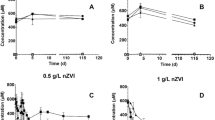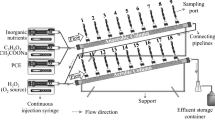Abstract
This study investigates an innovative dechlorination process using anaerobic granular sludge that was partially exposed to oxygen. The exposure supported a synchronously anaerobic and aerobic bioconversion process that combined reductive dechlorination with aerobic co-oxidation in a sludge granule. Experimental results showed that the highest dechlorination rates of tetrachloroethene, trichloroethene, cis-dichloroethene and vinyl chloride were 6.44, 2.98, 1.70 and 0.97 nmol/gVS day, at initial O2 concentrations of 10, 100, 5 and 0%, respectively. Strictly anaerobic conditions favored the dechlorination of vinyl chloride while absolutely aerobic conditions were preferred for trichloroethene dechlorination. Microaerophilic conditions are suggested to ensure the overall biodegradation of the chlorinated ethenes present in groundwater as a mixture.
Similar content being viewed by others
Explore related subjects
Discover the latest articles and news from researchers in related subjects, suggested using machine learning.References
Beunink J., Rehm H.J., 1988. Synchronous anaerobic and aerobic degradation of DDT by an immobilized mixed culture system Applied Microbiology and Biotechnology 29:72–80
Beunink J., Rehm H.J., 1990. Coupled reductive and oxidative degradation of 4-chloro-2-nitrophenol by a co-immobilized mixed culture system Applied Microbiology and Biotechnology 34:108–115
Chang H.L., Alvarez-Cohen L., 1995 Model for cometabolic biodegradation of chlorinated intermediates Environmental Science and Technology 29:2357–2367
Hörber C., Christensen N., Arvin E., Ahring B.K., 1999. Tetrachloroethene dechlorination kinetics by Dehalospirillum multivorans immobilized in upflow anaerobic sludge blanket reactors Applied Microbiology and Biotechnology 51:694–699
Hwu C.-S., Donlon B., Lettinga G., 1996. Comparative toxicity of long-chain fatty acid to anaerobic sludge from various origins Water Science and Technology 34:351–358
Hwu C.-S., Lu C.-J. & Liu, H.-P. 2002 Simultaneous anaerobic and aerobic dechlorination of PCE in granular sludge. In Proceedings of the Third International Conference on Remediation of Chlorinated and Recalcitrant Compounds held at Monterey, CA, ed Gavaskar, A.R. & Chen, A.S.C. CD-ROM 2H-36. Columbus, OH: Battelle. ISBN 1-57477-132-9
Kato M.T., Field J.A., Lettinga G., 1993. High tolerance of methanogens in granular sludge to oxygen Biotechnology and Bioengineering 42:1360-1366
Lettinga G., van Velsen A.F.M., Hobma S.W., de Zeeuw W., Klapwijk A., 1980. Use of upflow anaerobic (USB) reactor concept for biological wastewater treatment, especially for anaerobic treatment Biotechnology and Bioengineering 22:677–734
Liu, H.-P. 2001 Treatment of tetrachloroethylene by anaerobic granular sludge. M.Sc Thesis, National Chunghsing University, Taichung, Taiwan
Sanz J.L., Rodríguez N., Amils R., 1997. Effect of chlorinated aliphatic hydrocarbons on the acetoclastic methanogenic activity of granular sludge Applied Microbiology and Biotechnology 47:324–328
Van Eekert, M.H.A. 1999 Transformation of chlorinated compounds by methanogenic granular sludge. Ph.D Thesis, Wageningen University, Wageningen, the Netherlands
Acknowledgements
Funding for this study was provided by the National Science Council, Taiwan, under Project No. NSC 92-2313-B-241-005. Part of the batch work described in this study was financially supported by the grant HKHSC-91-02.
Author information
Authors and Affiliations
Corresponding author
Rights and permissions
About this article
Cite this article
Hwu, CS., Lu, CJ. Enhanced dechlorination of chloroethenes by granular sludge under microaerophilic conditions. World J Microbiol Biotechnol 22, 841–844 (2006). https://doi.org/10.1007/s11274-005-9112-2
Received:
Accepted:
Published:
Issue Date:
DOI: https://doi.org/10.1007/s11274-005-9112-2




